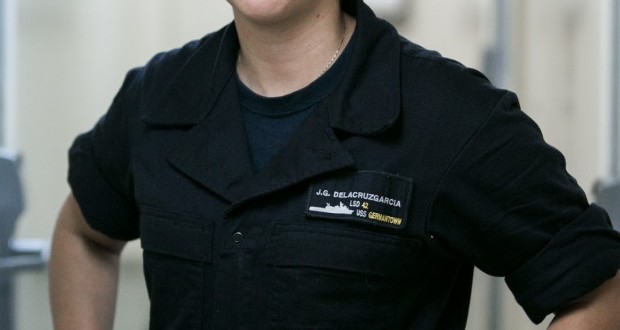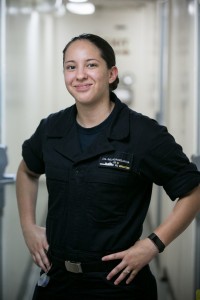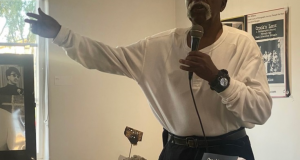By Chief Petty Officer Bill Steele, Navy Office of Community Outreach
A 2014 Los Altos High School graduate and San Bernardino, California native is serving in Japan in the U.S. Navy aboard USS Germantown.
Fireman Janeth Delacruz Garcia is an engineman aboard the ship operating out of Sasebo, Japan.
A Navy engine man is responsible for the maintenance of diesel engines, high pressure air compressors, lube oil purifiers and main reduction gears on the Germantown.
“Right now, I do a lot of testing of oil and fuel samples from the diesel engines,” said Delacruz Garcia. “I never would have thought I would be working in this field when I joined the Navy.”
With more than 50 percent of the world’s shipping tonnage and a third of the world’s crude oil passing through the region, the U.S. has historic and enduring interests in this part of the world.
“Our alliance is rooted in shared interests and shared values,” said Adm. Harry Harris, U.S. Pacific Command Commander. “It’s not hyperbole to say that the entire world has benefited from the U.S.-Japan alliance. While our alliance helped stabilize the region after the Second World War, it also enabled the Japanese people to bring about an era of unprecedented economic growth. And for the last six decades, our Soldiers, Sailors, Airmen, Marines and Coast Guardsmen have worked side by side with the Japan Self Defense Force to protect and advance peace and freedom.”
Commissioned in 1986, Germantown is the second Navy ship named after the Revolutionary War Battle of Germantown. With a crew of more than 900 sailors and Marines, Germantown is 609 feet long and weighs approximately 16,000 tons. Designed specifically to operate landing craft air cushion small craft vessels, Whidbey Island-class dock landing ships have the largest capacity for these landing craft out of any U.S. Navy amphibious ship.
“This is my first command, the work environment is very respectful, they’re all very supportive and communicate well,” said Delacruz Garcia. “Serving in Japan is great, it’s one of my dream places to serve.”
Sea duty is inherently arduous and challenging but it builds strong fellowship and esprit de corps among members of the crew. The crew is highly motivated and quickly adapt to changing conditions. It is a busy life of specialized work, watches, and drills.
“I’m the first to serve in the Navy in my family,” said Delacruz Garcia. “It’s a huge commitment, I don’t think I could have done it without their support.”
The Navy’s presence in Sasebo is part a long-standing commitment.
“The U.S.-Japan alliance remains the cornerstone for peace and stability in the Indo-Asia-Pacific region,” said Harris.
Fireman Janeth Delacruz Garcia is an engineman aboard the ship operating out of Sasebo, Japan.
A Navy engine man is responsible for the maintenance of diesel engines, high pressure air compressors, lube oil purifiers and main reduction gears on the Germantown.
“Right now I do a lot of testing of oil and fuel samples from the diesel engines,” said Delacruz Garcia. “I never would have thought I would be working in this field when I joined the Navy.”
With more than 50 percent of the world’s shipping tonnage and a third of the world’s crude oil passing through the region, the U.S. has historic and enduring interests in this part of the world.
“Our alliance is rooted in shared interests and shared values,” said Adm. Harry Harris, U.S. Pacific Command Commander. “It’s not hyperbole to say that the entire world has benefited from the U.S.-Japan alliance. While our alliance helped stabilize the region after the Second World War, it also enabled the Japanese people to bring about an era of unprecedented economic growth. And for the last six decades, our Soldiers, Sailors, Airmen, Marines and Coast Guardsmen have worked side by side with the Japan Self Defense Force to protect and advance peace and freedom.”
Commissioned in 1986, Germantown is the second Navy ship named after the Revolutionary War Battle of Germantown. With a crew of more than 900 sailors and Marines, Germantown is 609 feet long and weighs approximately 16,000 tons. Designed specifically to operate landing craft air cushion small craft vessels, Whidbey Island-class dock landing ships have the largest capacity for these landing craft out of any U.S. Navy amphibious ship.
“This is my first command, the work environment is very respectful, they’re all very supportive and communicate well,” said Delacruz Garcia. “Serving in Japan is great, it’s one of my dream places to serve.”
Sea duty is inherently arduous and challenging but it builds strong fellowship and esprit de corps among members of the crew. The crew is highly motivated and quickly adapt to changing conditions. It is a busy life of specialized work, watches, and drills.
“I’m the first to serve in the Navy in my family,” said Delacruz Garcia. “It’s a huge commitment, I don’t think I could have done it without their support.”
The Navy’s presence in Sasebo is part a long-standing commitment.
“The U.S.-Japan alliance remains the cornerstone for peace and stability in the Indo-Asia-Pacific region,” said Harris.
 Westside Story Newspaper – Online The News of The Empire – Sharing the Quest for Excellence
Westside Story Newspaper – Online The News of The Empire – Sharing the Quest for Excellence





